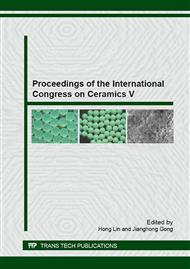p.230
p.234
p.240
p.244
p.249
p.253
p.258
p.263
p.267
Effects of CaO-Li2O-K2O-Na2O Fluxing Agents on the Properties of Porcelain Ceramic Tiles
Abstract:
With the rapid development of the world's industrial, issues of energy and environment have increasingly been prominent. Currently, the cost of building ceramics production needs a large number of raw materials and fuel, how to save energy and reduce consumption in building ceramic process is still hot spot of domestic and international research and the main development trends. Reducing the sintering temperature is one of the most efficient ways for energy conservation and consumption. In order to reduce the sintering temperature, fluxing agents are often used in preparing ceramic products. In this paper, the ceramic green bodies were prepared by mixing clays, lithium China stone and grammite, equivalent to “K2O-Na2O-Li2O-CaO” normally used as fluxing agents. The effects of grammite on the properties of ceramic body were studied. The sintering behavior of the samples was evaluated by water absorption and bulk density. The fired samples were characterized by X-ray diffraction (XRD), scanning electron microscopy (SEM) equipped with an energy dispersive X-ray spectroscopy (EDS) and bending strength measurements. The results showed that the optimum sintering temperature range of 40 °C and bending strength of 60 MPa could be achieved in the presence of 3 wt % grammite. The obtained results are useful in low-temperature sintering porcelain ceramic application.
Info:
Periodical:
Pages:
258-262
Citation:
Online since:
July 2015
Authors:
Price:
Сopyright:
© 2015 Trans Tech Publications Ltd. All Rights Reserved
Share:
Citation:


